Key Insights
- Cardano’s TVL increased 166% QoQ and 693% YoY. Cardano’s TVL ranking increased from 34th at the beginning of 2023 to 11th.
- Cardano’s stablecoin value increased 37% QoQ and 673% YoY. iUSD remained the market cap leader, but alternative solutions such as USDM are approaching mainnet.
- ADA’s price increased 127.2% QoQ, outpacing the overall crypto market’s increase of 53.8%.
- The specifications for Midnight were released, such as the use of Substrate. Midnight is a data-protection-focused partner chain/sidechain.
- Core infrastructure — such as SanchoNet, Hydra, and Mithril — continued development and testing.
Primer
Cardano (ADA) is a Proof-of-Stake (PoS) Layer-1 smart contract network launched in 2017. Cardano aims to provide security, scalability, and sustainability to decentralized applications and systems building on top of the blockchain. In addition to the community of developers, node operators, and projects, Cardano is supported by multiple entities: Input Output Global (IOG), dcSpark, MLabs, The Cardano Foundation, EMURGO, and more. They work together to support the network’s development, adoption, and finances while Cardano moves toward the age of Voltaire.
Cardano has taken a unique approach to development when compared to other smart contract networks. The Ouroboros consensus model allows for delegation of stake, the extended unspent transaction output (eUTXO) accounting model enables native token transfers, scalability, and decentralization, and smart contracts were enabled by the Alonzo hard fork in 2021.
With a dedicated community of users and developers, Cardano has demonstrated staying power. Post-Alonzo, Cardano began to compete in more traditional crypto markets, such as DeFi and NFTs. For a full primer on Cardano, refer to our Initiation of Coverage report.
Website / X (Twitter) / Telegram
Key Metrics

Financial Analysis
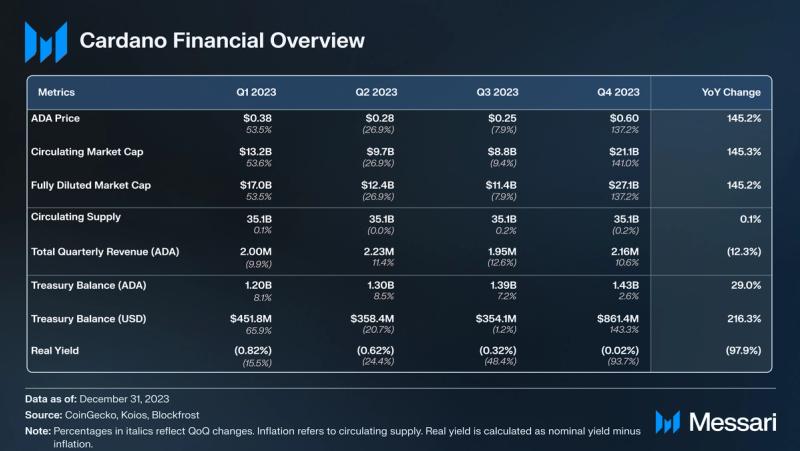
ADA’s price increased 127.2% QoQ, outpacing the overall crypto market’s increase of 53.8%. This Q4 increase brought ADA’s YoY change to 145.2%. ADA is the native asset of Cardano. It has three primary use cases: (1) settling network fees, (2) being used to register a stake pool to participate in network consensus as a pool operator, and (3) staking as a pool operator or delegator to help secure the network and earn token rewards.
In November, the SEC once again alleged ADA to be a security — along with other assets including SOL, ATOM, and NEAR — in a case with Kraken. Unlike the SEC cases earlier in 2023, this instance did not trigger significant price volatility in ADA.
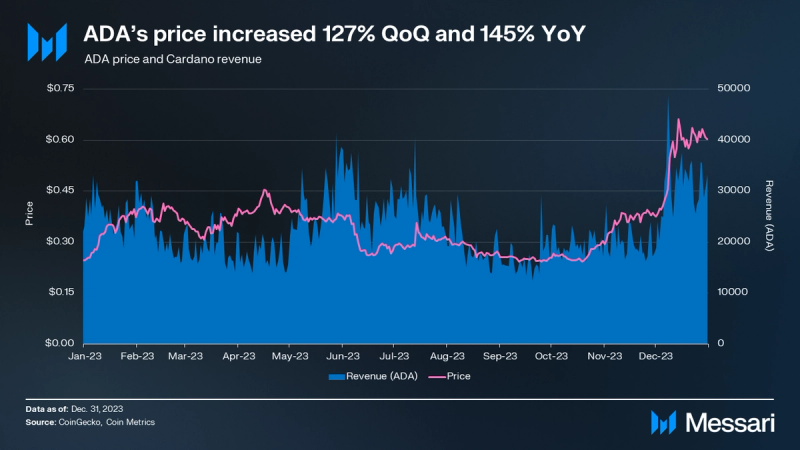
Revenue (USD) increased 66.7% QoQ. However, this wasn’t all due to ADA’s price action, as revenue (ADA) also increased: by 10.6% QoQ.
Cardano’s Treasury balance grew 2.6% QoQ to 1.43 billion ADA. The 40 million ADA increase was generally in line with growth from previous quarters. Currently, 20% of all transaction fees go to the treasury, which can be changed via governance as needed.
The nominal staking yield on Cardano is generally 3.3% for ADA delegators, although it can vary by stake pool. Real yield is calculated as nominal yield minus inflation, which accounts for any value dilution due to inflation. In Q4, real yield was -0.02%. ADA’s supply is capped at 45 billion, but the active supply does experience “inflation” until it reaches that limit. In each epoch, 0.3% of ADA reserves (i.e., the ADA not in circulation) are distributed as stake pool operator (SPO) rewards. This “inflation” trends towards zero as the reserves deplete and the circulating supply approaches 45 billion.
Network Analysis

Each transaction on the network is accompanied by a fee for processing actions and storage costs. Fees are calculated by a minimum payable fee in addition to transaction size. The average transaction fee (USD) increased 50.4% QoQ from $0.10 to $0.15. On the other hand, the average transaction fee (ADA) did not change QoQ. The disparity indicates that ADA’s price action was almost completely responsible for the increase denominated in USD.
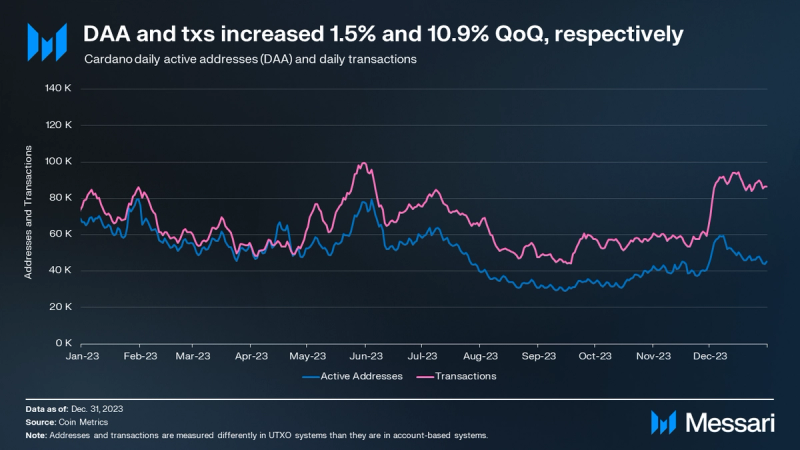
Cardano’s average daily transactions grew by 10.9% QoQ, outpacing the 1.6% QoQ growth in daily active addresses. The ratio of transactions to active addresses grew steadily over the past year, suggesting an increase in “power users.” The Q4 Transaction / Active Address ratio of 1.60 was up 9.2% QoQ and 45.0% YoY.
The increased average activity per user could be a result of all the newly launched and developed protocols in 2023 — specifically DeFi protocols. These will be explored further in the Ecosystem Analysis section.
Staking
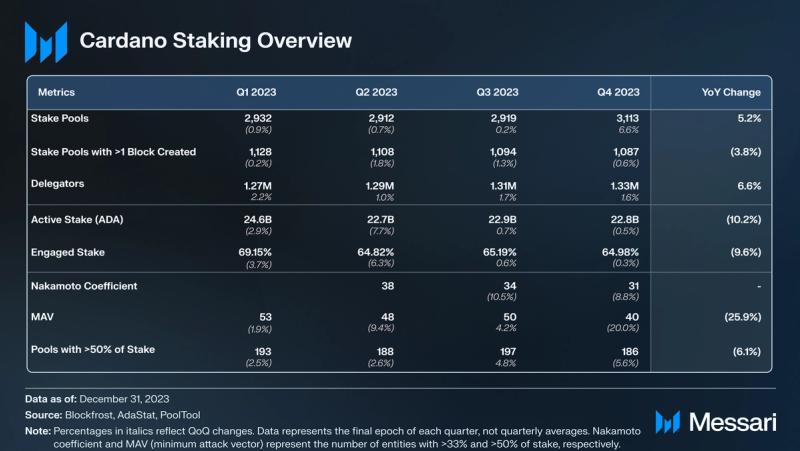
The number of stake pools (with more than one block created) was flat, decreasing 0.6% QoQ. Delegators, on the other hand, increased 1.6% QoQ. Overall, these consensus metrics did not change significantly in Q4.
Stake pools are run by various entities, such as individuals (public or anonymous) or organizations (crypto-native or other). Regardless of the entity in charge, many stake pool operators (SPOs) operate several pools due to the current incentives limiting the maximum size of a pool. Accounting for multi-pools, there were 1,982 unique SPOs (1,804 single-pool operators and 178 multi-pool operators) in Q4. However, the real number of SPOs may be slightly lower since not all SPOs identify their pools in ways that can be linked.
In October, the Cardano Foundation made a forum post to lay out the changes to its delegation strategy. In addition to delegating to single-pool operators, the Cardano Foundation now also delegates to multi-pool operators, supporting the broadest community of ecosystem builders.
Stake and delegator distribution have been historically unbalanced across total pools. Of the 22.8 billion total staked ADA in Q4, the top 186 pools (6.0% of pools) accounted for over 50%. A beta feature in the Lace wallet enabled users to stake ADA across multiple pools in Q4 2023, which would grant delegators more flexibility over their stake distribution. While those top 186 pools would technically make the minimum attack vector (MAV), there are actually only 49 entities, as many of the top pools are run by multi-pool operators. Another measure of decentralization, the Nakamoto coefficient, ended the quarter at 31.
While 49 (MAV) and 31 (Nakamoto coefficient) are low numbers relative to the total number of pools and delegators, they’re considerably higher than many other networks. The Edinburgh Decentralization Index (EDI) offers another framework to measure decentralization.

Active stake was flat for the second quarter, declining 0.5% QoQ to 22.8 billion ADA. Engaged stake was similarly flat in the second half of 2023. However, active stake and engaged stake were both down YoY by 10.2% and 9.6%, respectively.
Mithril
In July, Mithril went live on mainnet in beta and produced its first snapshot. Since then, over 100 stake pools have joined the network to sign Mithril certificates. Mithril is a stake-based multisignature scheme intended to help scale the Cardano network. It offers a lightweight, efficient experience and a secure alternative for users and applications to access all or parts of the state of the chain. Its users do not require access to the full chain, yet they receive a similar level of trust. As such, Cardano’s network becomes more efficient, streamlined, and capable of supporting a wider range of applications and use cases.
Mithril will enable applications such as
- “Light” wallets with no additional trust assumptions
- Fast bootstrapping of full nodes
- Efficient voting systems
As of the end of Q4, there were 96 SPOs participating as Mithril signers, totaling 1.79 billion ADA in stake. Improvements to the download and extraction process reduced the bootstrapping times for Cardano nodes to under 20 minutes on a consumer-grade laptop.
Mithril is both a novel cryptography scheme and a network of signing nodes deployed alongside the Cardano network. Mithril signers are lightweight processes run by SPOs alongside block producers which produce stake-based signatures sent to aggregators. Mithril clients can download and verify certified snapshots from untrusted so-called aggregators. They can then use those snapshots to resolve chain synchronization, state bootstrapping, and chain validation.
SanchoNet
SanchoNet was launched in Q3 in the node V8.2.1 pre-release, marking a milestone for onchain governance. SanchoNet is a testnet for Cardano’s onchain governance, as defined by CIP-1694 guidelines and as a core initiative of the Voltaire roadmap phase. Users can interact with SanchoNet through the NuFi and Lace wallets, and there is now a governance dashboard in active development.
Voltaire will take the final steps toward self-sustainability via onchain voting and offchain mechanisms and institutions, including the member-based organization, Intersect. After completion, the community will be able to determine parameter changes, implement hard forks/ upgrades, and transfer responsibility over from IOG, Cardano Foundation, and EMURGO — which combined hold all seven governance (genesis) keys. Voltaire will also enable Treasury withdrawals to fund Cardano’s continuing development via community vote.
The infrastructure required for a successful onchain voting platform does not yet exist. To meet this need, SanchoNet serves as a sandbox to test and build out not only processes but also tools. Developers can use the testnet to launch new infrastructure (e.g., wallets and vote explorers), SPOs can test voting/proposing to find pain points, and a new user role — delegate representatives (DReps) — can be hashed out.
SanchoNet is championed by Intersect — a member-based organization for the Cardano ecosystem — among other community members, SPOs, and teams. Intersect launched with the aim of bringing ADA holders together behind a shared vision to enable a more transparent and innovative Cardano ecosystem. Intersect is heavily aligned with Voltaire and bottom-up coordination for further decentralization.
Ecosystem Analysis
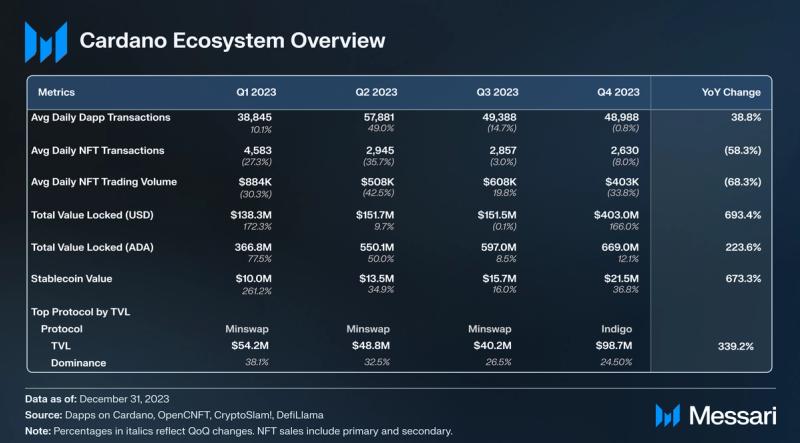
The Cardano ecosystem saw serious growth in Q4:
- TVL (USD) increased 166% QoQ and 693% YoY. Indigo flipped Minswap to become the largest protocol by TVL.
- Stablecoin TVL increased 37% QoQ and 673% YoY. Mehen’s USDM fiat-backed stablecoin will be available in March, adding another option to the existing iUSD, DJED, and Wanchain bridged stablecoins.
- Scaling infrastructure such as Hydra and Mithril continued to be developed, while tools on live on mainnet such as Paima Engine saw continued developer adoption.
- Specifications for Midnight, a partner chain, were released.
While TVL is one metric to measure an ecosystem, it should not be the only metric. Many dapps and services won’t meaningfully contribute to TVL in the way that a lending protocol can. For example, Iagon — a decentralized storage solution — will not be a TVL driver because it is infrastructure. Even within DeFi, aggregators such as DexHunter and non-custodial platforms such as Axo do not contribute to TVL directly.

Average daily dapp transactions were flat QoQ, decreasing 0.8%. However, dapp transactions were up 38.8% YoY. This YoY increase was mainly due to increased DeFi activity, as NFT marketplace activity lagged.
Minswap and Liqwid Finance are two of many protocols that saw significant activity growth in 2023:
- Minswap, an automated market maker (AMM), has been the most popular Cardano dapp by transactions since dethroning NFT marketplace jpg.store three quarters ago. Minswap remained the most-used dapp in Q4 partially due to its massive December volume. In December, Minswap transactions increased 140% QoQ to 971,000. Minswap’s in-development Stableswap feature may help the protocol drive even more activity by providing minimal slippage and more efficient trading.
- Liqwid Finance, a lending and liquid staking protocol, has also been steadily growing in activity. It has moved up to the third most popular dapp by transaction volume in just under one year.
DeFi
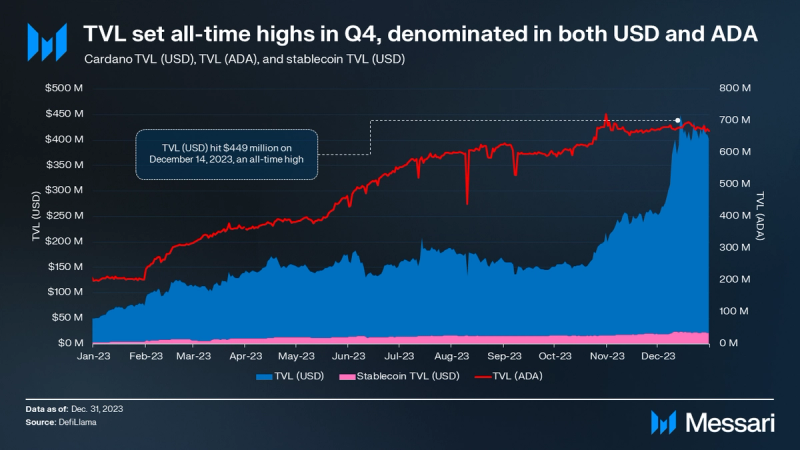
TVL (USD) increased 166.0% QoQ, setting an all-time high of $449 million on December 14. This massive Q4 contributed to a 693.4% YoY increase. Cardano’s TVL ranking among all networks increased from 15th to 11th during Q4 (starting at 34th at the beginning of the year). TVL (ADA) also set an all-time high in Q4, peaking at just over 700 million ADA.
Early in 2023, Cardano’s TVL growth was catalyzed by the introduction of new stablecoins: iUSD and DJED. Stablecoins continued to be a good indicator for DeFi health in Q4 as the stablecoin total value locked increased 36.8% to $21.5 million. Relative to other networks, Cardano’s stablecoin market cap moved up from 54th to 32nd in 2023. Stable assets are ideal for pairing in liquidity pools, borrowing and lending, creating leverage, and providing quick escapes from volatility — all of which are quite common in the crypto market.
Like iUSD and DJED, Mehen’s USDM stablecoin may create a similar effect once it launches in Q1 2024. Different users prefer different architectures, and USDM will be the first of its kind on Cardano. Unlike iUSD and DJED, Mehen’s USDM is not algorithmic or synthetic; it’s 1:1 fully backed with U.S. dollars. Indigo’s iUSD has had an inconsistent peg, something that can’t happen with 1:1 backing and more accessible redemptions to create arbitrage opportunities.
Wanchain — an L1 PoS EVM blockchain and a decentralized blockchain interoperability solution — has made USDT and USDC available on Cardano through its various bridges. Wanchain’s bridges are secured by Wanchain validators, connecting Cardano to Wanchain, Bitcoin, Ethereum, TRON, and more. Bridged versions of Bitcoin and USDT/USDC (the largest stablecoins by market cap in all of crypto) have created a massive liquidity opportunity for Cardano DeFi.
Smart token standards such as CIP-68 or CPS-0003 could open the door for built-in compliance, allowing USDC to be natively available on Cardano as well. One more Cardano-native stablecoin on the horizon is Anzens’ USDA.
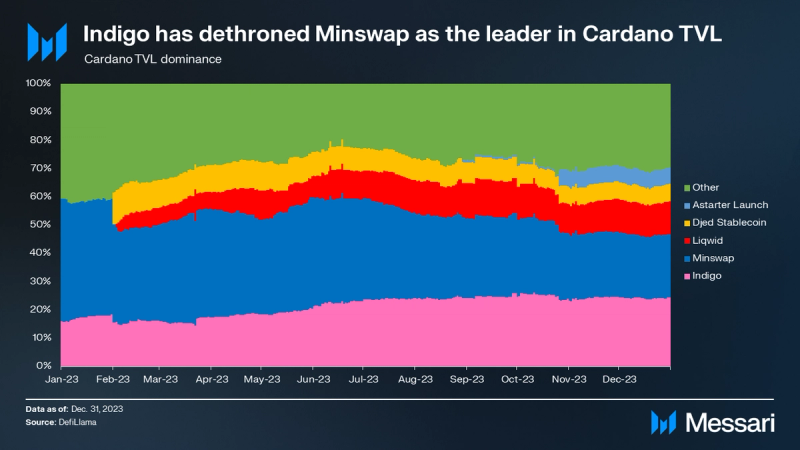
Much of the 2023 TVL growth was driven by newer protocols. Synthetic asset-issuer Indigo is the oldest and largest of these new (launched in the past year or so) protocols. It managed to dethrone Minswap in Q4, ending Minswap’s multi-year reign as the TVL leader.
This change was not a result of Minswap’s decline. In fact, Minswap’s TVL increased 124% QoQ. Indigo simply outpaced Minswap with a 165% QoQ growth in TVL. Indigo and Minswap ended Q4 with $97.5 million and $89.6 million in TVL, respectively.
TVL and DeFi ecosystem growth has come with growing pains, specifically for DEXs. Cardano’s novel eUTXO mechanism brought new DeFi paradigms with it, such as batching and transaction chaining. Many DEXs are exploring new or improved solutions, such as MuesliSwap working on transaction chaining. Transaction chaining, already implemented on protocols such as Optim, should be an improvement over MuesliSwap’s contested batching process.
Partner Chains
Partner chains is an encompassing term that can include technically sovereign sidechains or modular networks. One of these partner chains is Midnight, an upcoming data-protection-focused sidechain for Cardano. By leveraging zero-knowledge cryptography, Midnight aims to bridge the principles of DeFi with the requirements of TradFi. It will enable users to have selective data disclosure while meeting regulatory needs. Unlike Milkomeda, Midnight will have its own token: DUST.
In Q4, several of Midnight’s features and use cases were announced. From a developer experience perspective, Midnight will use a language designed to integrate with Typescript and built on Substrate — a development framework popularized by Polkadot. This isn’t the first synergy between the two ecosystems, as Polkadot’s consensus is built on top of Ouroboros. The initial devnet has onboarded over 600 dev teams since it launched in November 2023.
Midnight’s use cases include identity verification, controlled access to tokenized digital assets, enhanced AI and LLMs, decentralized credit scoring, decentralized anonymous voting, and more.
Cardano has a handful of other sidechains — some live in production and some still in development. Some of these networks include Milkomeda C1, Wanchain, Midnight, and World Mobile.
Milkomeda C1 launched in early 2022 as Cardano’s first sidechain. It initially brought EVM compatibility to the Cardano ecosystem, but in early September, it brought EVM compatibility directly to Cardano wallets. Milkomeda C1 is primarily maintained by dcSpark. Most of Milkomeda’s activity comes in the form of games built with Paima Engine — a framework for rollups focused on creating onchain games and autonomous worlds. Unlike all other current rollups (including Ethereum rollups which use centralized sequencers), Paima-built rollups are true rollups with decentralized sequencing/proving, like Fuel V1.
NFTs
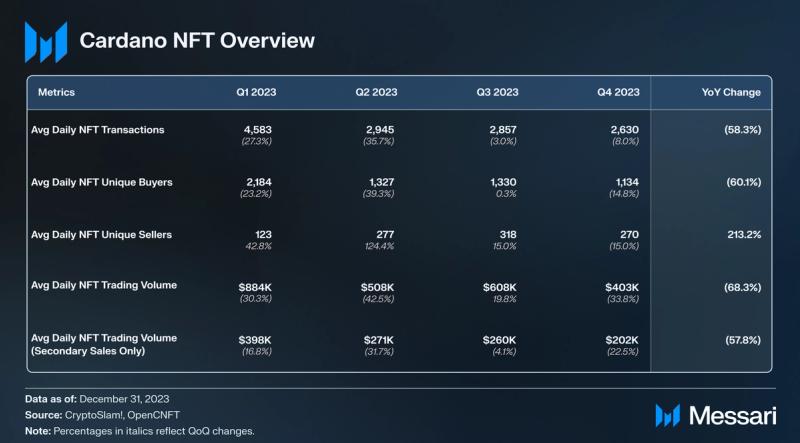
NFT activity declined across the board in Q4. Transactions and trading volume were down 8.0% and 33.8% QoQ, respectively. The state of Cardano NFTs was even worse on an annual scale, with transactions and trading volume decreasing 58.3% and 68.3% YoY, respectively. Unique sellers was the lone metric to increase in 2023, with a 213.2% YoY increase to an average of 270 unique sellers per day.
Despite the declines in metrics, builders continued to innovate. For example, the Tiamonds team tokenized a diamond and put it onchain, using an NFT as its onchain representation. Real-world assets are a growing trend across various networks, and both fungible and non-fungible tokens have applications for these tokenizations. Other NFT innovations are coming in the form of books and gaming, from the Book.io and Paima Engine projects, respectively.
Hydra
In Q4, Hydra V0.14.0 was released. Hydra is a family of scaling protocols, mostly L2s based on state channels. Hydra Head, the first solution from the set, is an offchain mini ledger. It works between a small group of participants, not unlike other popular state channels such as Lightning. Hydra leverages the eUTXO model for a more efficient and flexible transfer from L1 to L2 and back, allowing for the isomorphic transfer of data. Hydra for Payments is an open-source toolkit for implementing payment solutions that will leverage Hydra Head.
The first Head on the Cardano mainnet, also known as a channel, was opened in a limited form in March 2023. As of writing, the protocol can be considered to be in a “public beta.” Until the protocol is more thoroughly tested, the quantity of ADA committed is limited for user safety. Builders from various teams are actively working on improvements to Hydra Head. Early applications include gaming, auctions, and P2P payments. At the Cardano Summit, masterclasses showed developers how to use Hydra for dapps and how it can work with Mithril. All in all, Hydra Head is a flexible protocol, with several proposed topologies.
Project Catalyst
Voting for Catalyst Fund11 began on January 24, 2024. Project Catalyst is a decentralized fund for innovative projects in the Cardano ecosystem. In this fund, ADA holders decide which proposals will receive funding from the ADA treasury. Through all 10 funding rounds, Catalyst has funded 1,344 proposals. Fund10, the most recent fund, ended in September 2023 with 192 funded proposals. dcSpark was the top-funded team with 6.26 million ADA ($1.6 million) in funding; its top-funded proposals were related to Paima Engine.
Participation and vote-selling (i.e., paying another user for their vote) are two points of focus in decentralized governance that affect nearly all groups and initiatives. The community has continued to explore different ways to improve its governance process. These include assessing proposals, verifying that funded projects have achieved their milestones, distributing funds, increasing participation, defining ecosystem funding priorities, and formalizing vote-selling.
Over its two-week voting period, Catalyst Fund10 received just under 410,000 votes, an increase of over 45,000 more than in the previous fund. The increase brought the total number of votes cast across Catalyst’s lifetime to more than 2 million. Fund10 saw 60,000 wallets registered with a total voting count of 4.5 billion ADA. However, only 7,900 of those wallets actually voted to confirm a proposal — 50% of which only voted on 10 or fewer of the over 1,000 total proposals.
The relatively low participation rate (in terms of both users and ADA) had some community members suggestingdifferent models and incentives. Due to Project Catalyst’s linear token-based voting (i.e., 1 token equals 1 vote), the top 1.5% of wallets controlled 56% of the voting power. Certain voting schemes, such as quadratic, conviction, and reputation-based voting, may be worth exploring to better distribute the voting power.
Fund10 voters approved the open-source Catalyst development roadmap to introduce liquid democracy to voting. Under this system, voting power can be delegated to representatives known as DReps to vote on behalf of the ADA holder. This enables stake pool operators and other individuals or groups with high delegations of ADA to play a greater role in influencing which proposals receive funding. Other schemes, such as holographic, are likely counterproductive in addressing vote-selling — should the community deem it to be an issue and not an opportunity for both yield and added transparency.
Optim Finance formalized vote-selling in Fund10 with its liquidity bonds — a vehicle to borrow and lend ADA delegation and, by extension, voting power. Optim’s model enables borrowers to pay a premium to gain additional voting power from lenders. Thus, a user can pay a relatively small premium to borrow votes for a single epoch for Catalyst proposals. Given that vote-selling already happens, making it a transparent process would only strengthen governance in the long term.
Cardano addresses have separate keys for payment and staking, enabling native liquid staking. In other words, users can deposit ADA on protocols (i.e., the protocol contract owns the payment key) without having to relinquish control of the stake key. This process is handled differently by various protocols:
- Indigo keeps the lender’s stake key attached to their own deposits, retaining voting rights for the lender.
- Minswap attaches its own stake key to the lender’s deposits, transferring voting rights to the protocol.
- Optim attaches the borrower’s stake key to the lender’s deposits, transferring voting rights to the borrower.
Development, Growth, and Community
Other notable developments and events in Q4 include:
- IOG acquired the non-custodial wallet Nami, originally funded by Project Catalyst.
- Cardano Foundation launched the Identity Wallet.
- The 2024 Cardano Summit in Dubai hosted panels, presentations, and masterclasses on new technologies — such as Hydra and Mithril.
- Educational initiatives such as IOG Academy, Cardano Academy, EMURGO Academy, Gimbalabs, Genius Academy, and IOG Working Groups continued to run.
- Intersect’s first committee update was released, recapping 2023.
Closing Summary
Q4 capped off a year of strong ecosystem growth. TVL (USD) and stablecoin value locked increased 166% and 37% QoQ, respectively. This surge in liquidity moved Cardano’s TVL ranking up from 34th to 11th over the course of the year. This growth was observed across established protocols like Minswap, which exhibited leading transaction activity, and newer entrants like Indigo, which emerged as the largest protocol by TVL in Q4. Simultaneously, Cardano’s infrastructure development continued.
On the Cardano mainnet, technologies such as Hydra and various DeFi projects funded by Project Catalyst progressed toward production, introducing new use cases for protocol developers. Beyond mainnet, partner chains and sidechains offer developers opportunities to leverage diverse execution environments. New liquidity and new infrastructure synergistically contribute to Cardano’s growth. Importantly, 2023’s ecosystem growth took place in parallel with the decentralization initiatives outlined in CIP-1694, SanchoNet, and Mithril.




















